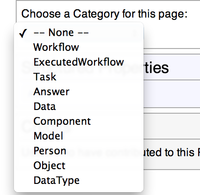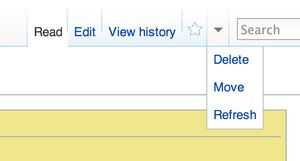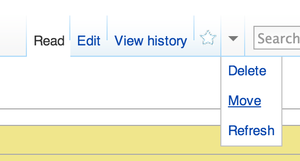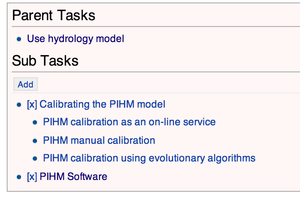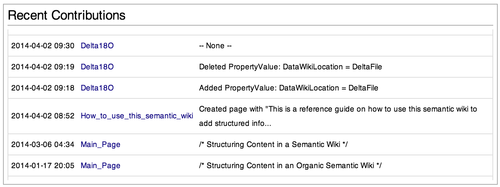Quick Reference Guide for How to Use This Wiki Site
This is a reference guide on how to use this semantic wiki to add structured information.
Contents
Getting an Account
To get an account in this wiki, please send email to Yolanda Gil with subject like "REQUEST FOR ORGANIC DATA SCIENCE ACCOUNT."
Adding New Text to Existing Pages
This wiki allows basic editing by adding regular wiki text and content. When editing, and before adding any text, click on the "Save Page" button at the bottom. After that select a category. Then you can either: 1) add structured properties by clicking on the "Add" button, or 2) add text and figures as in any other wiki by clicking on the "Edit" button at the top right. To format text and figures, see the Quick Guide to Using a Wiki.
Specifying Mathematical Formulas
It is possible to specify mathematical formulas within the text of any page. See this page for more information.
Adding comments
You can add comments to text by having a column every time you want to indent. Choose a unique color from this palette and use it in your comments.
- This user makes a comment in red -- User1
- This user responds to the comment in green -- User2
Adding and Editing Pages
Creating a new Page
Just go to http://www.organicdatascience.org/index.php/New_Page
[Replace "New Page" above to the name that you want for the page]
Then, either select a category for this page:
or, just click on the "Create" link to create a page without any category
Deleting a Page
Go to http://www.organicdatascience.org/index.php/Name_of_Page
[Replace "Name of Page" above to the name of the page to delete]
Then click on the "Delete" link, and delete the page.
Renaming a Page
Go to http://www.organicdatascience.org/index.php/Name_of_Page
[Replace "Name of Page" above to the name of the page to rename]
Then click on the "Move" link, and set the new name
Adding Structured Data
All pages in this wiki (except the Main Page) have a "Structured Data" Section.
Asserting Property Values
A user can click on the "Add" button to add a Property and Value pair. Matching properties in the wiki are suggested to the user as he types. In case the user decides to write his own property, this property is then automatically added to the wiki.
Deleting Property Values
Click on the [x] link next to the Property Value pair that you want to delete.
Setting Property Type
The type of a property is guessed by the value that the user puts in while asserting a property value. In case, the user wants to set the property type himself, he can go to the property page ( http://www.organicdatascience.org/index.php/Property:Name_of_Property ) and edit the wiki text to change the type.
For example, if one goes to Property:Resolution, he sees the following.
On Editing the wiki text
Directly creating a new property
Create a new page for the property by navigating to http://www.organicdatascience.org/index.php/Property:Name_of_New_Property
Deleting a property
Navigate to the property page ( http://www.organicdatascience.org/index.php/Property:Name_of_Property ), and Delete it. (Refer to Deleting a page above on how)
Note: Deleting the property page will not automatically delete assertions of that property in other pages. That will have to be done manually.
Renaming a property
Navigate to the property page ( http://www.organicdatascience.org/index.php/Property:Name_of_Property ), and Move it. (Refer to Renaming a page above on how)
Note: Renaming the property page will not automatically rename assertions of that property in other pages. That will have to be done manually.
Categories
Task Category
A Task category page allows the user to describe a Task and specify its subtasks and answers.
Person Category
A Person category page is associated with a Wiki User ID by the "Has User ID" property. Add this in the Structured Data section.
Once, this is done then the Person Category page will have the following UI to show the user's contributions to the wiki:
Other Categories
The ODS framework has capabilities for other categories, including data, software, workflows, and others. If you are interested in this capability, please contact the PI.
Credits for Users
At the bottom of each page (except the main page), credits are shown to show which users have edited that page.
Using Structured Content to Dynamically Create Sections of Wiki Pages
Those properties can then be used to answer queries that aggregate automatically those properties and pages. Below are some examples of how a query can be stated using those structured properties, and the automatically generated table that answers the query.
These queries can be used to create dynamically generated content in the page where the query appears.
Example:
{{ #ask: [[Is a::researcher]]
| ?has_website
| ?home_institution
| default=No researchers are described in this site
}}
What shows up on the wiki page:
| Has website | Home institution | |
|---|---|---|
| Kelly Cobourn | http://frec.vt.edu/people/cobourn/index.html | Virginia Tech |
| Yolanda Gil | http://www.isi.edu/~gil | University of Southern California |
The empty cells indicate that the information has not been provided for that researcher. If the page of the researcher is edited and the information added, come back to this page and see how the table changes to reflect the update.
Accessing Structured Content Externally
The structured content in this semantic wiki is represented with the W3C RDF semantic representation standard. This allows others to access and import the content of this wiki into their applications. There is extensive documentation about this API here.
